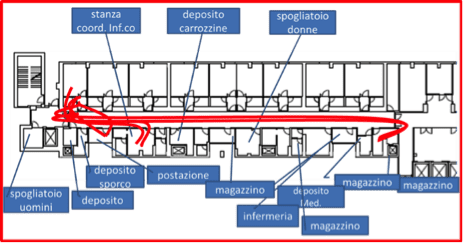
Nurses and doctors tell us how they are changing their ward
FEATURE – Every year, Siena University Hospital runs a Lean Day to celebrate and award its best lean healthcare projects. In this new series, front-line people write about five of these initiatives.
Words: Internal Medicine Team (Angela Baldacchino, Lucia Bellandi, Caterina Bianciardi, Carla Caffarelli, Carlo Duma, Guido Fruscoloni, Giovanna Millozzi, and Teresa Troisi)
Long waiting times represent a major problem for hospitals around the world, and our organization is not immune to this. Patients in need of a bed in our Internal Medicine wards used to patiently wait in the ER for hours, often until the late afternoon, which isn’t exactly in line with their definition of value. This situation was even harder to accept if we consider the fact that there are ways to predict the time of the day in which we normally receive the highest number of patients – all we needed was a different way of thinking.
In our wards the bed occupancy rate is around 99% and discharges typically happen in the afternoon, starting at 2pm. This habit has become reinforced over the years, initiating a chain reaction resulting in our patients waiting for a bed to free up for hours on hand – often until late at night (in fact, 90% of night admissions from the Emergency Room take place in Internal Medicine).
Our area has a rather complex structure: it is composed of two operating units with a total of 76 beds (60 of each are located in our two Internal Medicine Units, with the other 16 situated in what we call our two “Departmental Areas”). To better manage this complexity, the hospital decided to re-organize the structure of the Medical Area and divide its work into Urgent and Planned – this meant creating a framework that moved past the rigid terms dictated by our management control analysis to accommodate a more strategic view.
To build on this change, in January 2016 we in Internal Medicine decided to run a lean project in the wards looking after urgent cases, in order to reorganize the flow of admitted patients and hopefully improve things.

We started by following some of the most effective techniques and principles in lean thinking – including value stream mapping, pull, waste elimination, and bottom-up employee engagement – in order to get as many people as possible involved in the improvements we were trying to make. We saw this as a necessary step to then launch the project officially.
To this end, we created a number of multifunctional groups that worked simultaneously on different aspects of the transformation. In particular, the group in charge of the more strictly medical elements of the improvement ran a three-day kaizen event to analyze the current state based on the available data. They also mapped and reviewed their activities in order to improve the patient flow, and established metrics they could use to measure their performance after the implementation of the changes. Some of the performance ojectives we were after: increasing the number of discharges taking place in the morning; planning next-day discharges and afternoon admissions; and guaranteeing a certain number of beds each days, depending on demand.
The project officially launched on May 4, 2016. We were very excited to see what five months of prep work would come to, and anxious to know whether our expectations would be met. Everybody was extremely motivated to make the new system a success, and four months later the results started to show: we indeed started to plan discharges one day before, using the Discharge Room more than ever before (in the morning its rate of utilization went up 345%), and reorganized the doctors’ work to ensure discharges and admissions would happen between 8am and 2pm. One of the most effective changes was the introduction of a daily meeting with doctors, nurses and nursing coodinators from the ER, Internal Medicine and Surgery. The aim of the meeting is to discuss different patients and create alignment between the demand coming from the Emergency Department and the number of beds available in Internal Medicine.
Whereas before patients used to wait a long time to be admitted to our Medical Area, with the introduction of our lean improvements we managed to eliminate all waiting by simply changing the patient pathway (which was previously very complex, often entailing an unnecessary stay in Emergency Medicine before we could welcome the patient in Internal Medicine).
A group of nurses and careworks also reviewed the entire layout of the three wards by means of a simulation through a spaghetti diagram. They found this was a fantastic way to map the every-day movement of workers across the wards and to highlight any useless and wasteful activities.
Using the analysis they carried out, the team was able to completely redesign the layout of the wards, hoping to achieve a 20% reduction in movement. They achieved a staggering 60% - dropping from 11 metres to 4.5 metres for one of the activities we perform.


In the meanwhile, another multifunctional group organized a workshop on the 5S technique – with three sub-teams running experiments with medical carts to get deeper into those practices. This resulted in the elimination of unused supplies, the freeing up of space in the wards, and in the review of all carts. Following an in-depth analysis by means of a Kato diagram, the team even designed a customized “model cart,” which perfectly responds to their requirements. The new carts have been ordered and are being built.

But that’s not where our 5S efforts stopped: we also rearranged the warehouses. We got rid of stock and reorganized our supplies and drugs based on actual usage. These activities, too, led to great results: not only did we bring order and tidiness to our warehouse, we also reduced the time nurses spend to replenish carts by 30% and the time coordinators spend to order materials by 50%.
Our change of course has further motivated us and our colleagues, developing our ability to approach problems practically and with a positive attitude, thus improving the productivity of the ward and the quality of the care we offer. Working with lean principles has required a big effort, but it has also awarded us with professional growth and the acquisition of invaluable new skills.
As we try to draw some lessons from our project, we believe that the key to its success was the fact that improvement ideas were brought forward by people at all levels of the organization, and supported with enthusiam by top management. The trust we were able to build was also critical to the success of our initiative: it required honesty, time, dedication and the acceptance of different viewpoints, but in the end it allowed us to achieve results that no plan or strategic move had previously managed to realize.
THE AUTHORS

The Siena University Hospital team who prepared this article:
Angela Baldacchino, nursing coordinator, Departmental Area, Internal Medicine
Lucia Bellandi, coordinating nurse for the Urgent clinical paths
Caterina Bianciardi, lean healthcare manager
Carla Caffarelli, doctor of internal medicine, Medicina Interna 1
Carlo Duma, nursing coordinator, Medicina Interna 1
Guido Fruscoloni, coordinating nurse for Planned clinical paths
Giovanna Millozzi, coordinating nurse of the Medical Area
Teresa Troisi, coordinating nurse, Medicina Interna 2
Read more


PROFILE – This month we meet another member of the lean community, a true pioneer of lean thinking, who contributed to introducing the methodology in Australian cities and healthcare organizations.


FEATURE – In this article we learn how the creation of an Obeya helped an international insurance company boost collaboration among functions and accelerate the delivery of an important IT project.


FEATURE – What is the key to improving the front-line construction work? Our lean construction coaches pull their experience together to shed a light on the subject.


FEATURE – Thanks to lean, a primary care unit in Catalonia has streamlined its blood sampling process, improving the patient experience and the life at work for its staff.

